Potholes, Detours and Other Driving Challenges Southeast of Cordoba, Mexico: Just Follow the Pigs, Keep Calm, and Have Faith
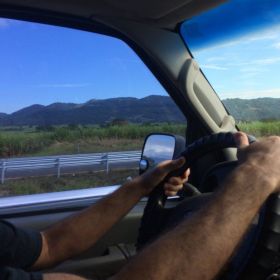 It all started so innocently.
It all started so innocently. It was mid-November, overcast, 72 degrees, with just a hint of rain in the air. On the highway a few hours after leaving Cordoba and headed southeast to our planned destination of Palenque, there were literally no other cars within sight in either direction. The road was high quality and safe. Even the shoulders were full width, as opposed to ¾ width shoulders we had seen so many times before, that were used for straddling between lanes to let faster traffic pass. And unlike in Baja and some other areas in Mexico, there weren’t even any signs warning of cattle that may wander into our lane. It was an easy place to let your guard down, reduce the act of driving to an autonomic nervous system response, and just enjoy the experience.
It was in this blissful, relaxed state that we turned off to our next highway. Within a few yards, the potholes appeared. Actually, I don’t know if the word “pothole” adequately describes the gaping, deep, more than bone-jarring and potentially car-destroying chasms sprinkled randomly about on what used to be the equivalent of an interstate but now that more resembled a mine field, and one presumably to be 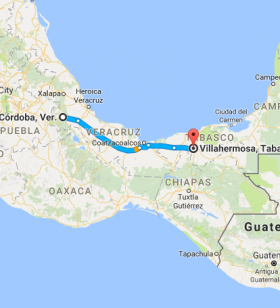 negotiated at highway speed.
negotiated at highway speed.
 negotiated at highway speed.
negotiated at highway speed. My wife, Jet, would call out the potholes she could see in advance, providing warnings like “Pothole right!”, “Pothole straight!”, etc., as well as, “Oops, missed that one!” Sometimes the potholes merged to encompass the entire width of the highway, so we would just have to hold on and hope we would emerge from the other side with car and dental work intact.
On previous roads, we had seen enterprising vendors selling their wares at stalls they had strategically placed on the sides of the road at slowdowns due to traffic construction. At the beginning of this experience, we were surprised we didn’t see them with bi-lingual signs reading, “Last chance to save thousands of dollars in chiropractic care—buy our neck braces before it’s too late!” Others would perhaps sell kidney belts.
They would have made a fortune.
And earned every peso.
.jpg)
Yet another dimension to our challenges was the light drizzle that had followed a rain hard enough to fill these craters with enough water to make their detection that much more difficult and their depth impossible to determine without smashing into them. As we would hit one, water would splash in all directions and our two dogs experienced the fun of being tossed up several inches, resembling Jacks in the Boxes or a larger version of “whack a mole.” I didn’t stop to look (too busy paying attention so as not to destroy our van or get into a serious collision), but some of the potholes were so huge and evidently there for so long that I wouldn’t be surprised if there were little fish swimming in them.
Dodging these caverns was like driving inside a video game. We couldn’t just stay in our lane, zone out and expect everything to work out, because if we did, it wouldn’t. I could hit a pothole so huge, our van may do a head plant, or at a minimum, bend something so badly I wouldn’t be able to drive it.
Adding to the fun, our video game became multi-player. While I was concentrating on keeping our van drivable, other drivers on our side of the road who were themselves avoiding their own potholes periodically and unpredictably swerved into our lane, so I had to avoid them as well. If this weren’t enough to keep me engaged, drivers from the other direction of traffic were swerving to avoid their own potholes, many times into my lane coming from the other direction.
.jpg)
Adding yet another dimension, this being Mexico, people were of course passing me, and of course, they were passing each other from the other side of the road, which for us would be oncoming traffic, resulting in a vehicular version of the game “chicken,” but with the fun of added road hazards. If one of them coming at us used our lane to pass from their direction, I had to make a split-second decision as to whether the driver on the other side of the road who had driven into my lane would move back in time to avoid hitting us. If I figured he would, I could stay where I was and in so doing, avoid my own pothole, to my right. If not, in order to avoid a head-on collision, I would have to move over and to drop into a pothole of unknown depth and ability to destroy our van.
Some drivers were very concerned about potholes, drove appropriately slowly and moved over to avoid each one, but others didn’t seem to mind too much, probably because they were driving someone else’s car.
After about an hour of this, we thankfully made it onto another highway, with three lanes in our direction that were nice, modern, and maintained. Then, about an hour or so after our internal organs had stabilized and our dogs went to sleep, I began to notice something a bit odd, and a bit worrisome: for several minutes, we hadn’t see a single vehicle coming in the other direction. This was not a good sign.
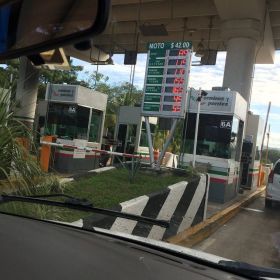
I can’t remember ever being happy about a detour, and this one looked like it may be a bad one. Also, we were in that part of our trip where we really didn’t have much of a Plan B. Past the pothole video arcade, more than halfway to our intended destination of Palenque to stay in a rustic hut by a nature preserve and no place to stay that we knew of prior to Palenque, we were committed to going forward, or it would be a very bad day.
Directly after the toll booth we were diverted from this nice highway with no oncoming traffic onto a road with only one lane in our direction, clogged with all the traffic that had just minutes earlier filled the three lanes from which we were just diverted. You can imagine our speed. And of course, this being an unplanned detour, the detour road was being repaired as well, which added more slowdowns.
Driving immediately in front of us was a truck transporting live pigs, several of which must have found us interesting, because they kept staring at us. It didn’t look as if they disapproved of us; they were just staring, somewhat puzzled.
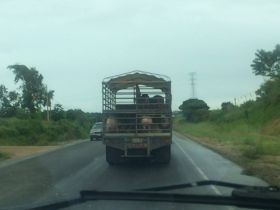 We had absolutely no idea what was going on, how long we would be on the detour, where we were going, specifically where we were, or pretty much anything else. We just followed the perplexed pigs.
We had absolutely no idea what was going on, how long we would be on the detour, where we were going, specifically where we were, or pretty much anything else. We just followed the perplexed pigs. Mile after mile we went, from hopeful speedup to demoralizing slow down to detour upon detour, the pigs our constant companion and vista. Minutes turned into more than an hour as the afternoon wore on. We came across a town now swollen with unanticipated traffic. Through it all, we plodded along.
In this town large enough to have cross-streets, several vehicles driven by people who seemed to be “in the know” made abrupt turns onto various side streets. We dared not follow their example, because we had no idea where we were.
Then, we witnessed another bad sign: several of the vehicles turned around completely and went back the way we came. A few  moments later, we saw an open-bed truck filled with people coming towards us from the other direction, stopping every few cars to yell something to drivers on our side. Sure enough, he did the same for us, looking at me directly in the face and informing me energetically in a loud voice in Spanish of something I couldn’t translate. After he passed, in my left side view mirror, I saw him tell others, some of whom turned around. Then, presumably after enough time to think about it, the driver of the pigs in front of us abruptly turned around, as well-- another bad sign. (We were, however, presented with some better scenery and a bit less porky condescension.)
moments later, we saw an open-bed truck filled with people coming towards us from the other direction, stopping every few cars to yell something to drivers on our side. Sure enough, he did the same for us, looking at me directly in the face and informing me energetically in a loud voice in Spanish of something I couldn’t translate. After he passed, in my left side view mirror, I saw him tell others, some of whom turned around. Then, presumably after enough time to think about it, the driver of the pigs in front of us abruptly turned around, as well-- another bad sign. (We were, however, presented with some better scenery and a bit less porky condescension.)
 moments later, we saw an open-bed truck filled with people coming towards us from the other direction, stopping every few cars to yell something to drivers on our side. Sure enough, he did the same for us, looking at me directly in the face and informing me energetically in a loud voice in Spanish of something I couldn’t translate. After he passed, in my left side view mirror, I saw him tell others, some of whom turned around. Then, presumably after enough time to think about it, the driver of the pigs in front of us abruptly turned around, as well-- another bad sign. (We were, however, presented with some better scenery and a bit less porky condescension.)
moments later, we saw an open-bed truck filled with people coming towards us from the other direction, stopping every few cars to yell something to drivers on our side. Sure enough, he did the same for us, looking at me directly in the face and informing me energetically in a loud voice in Spanish of something I couldn’t translate. After he passed, in my left side view mirror, I saw him tell others, some of whom turned around. Then, presumably after enough time to think about it, the driver of the pigs in front of us abruptly turned around, as well-- another bad sign. (We were, however, presented with some better scenery and a bit less porky condescension.) We couldn’t come up with a better plan of action than to just soldier on. In about an hour more, the traffic on our side had come to a complete stop. We saw drivers and passengers get out of their vehicles that were stopped in the middle of the road, joining others who had gotten out earlier and who were milling around. On the other side of the street going in the other direction was not 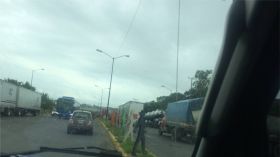 a single vehicle. Our side was a parking lot. Fortunately, there was a gas station near by with a small store. Unfortunately, it began to drizzle again.
a single vehicle. Our side was a parking lot. Fortunately, there was a gas station near by with a small store. Unfortunately, it began to drizzle again.
 a single vehicle. Our side was a parking lot. Fortunately, there was a gas station near by with a small store. Unfortunately, it began to drizzle again.
a single vehicle. Our side was a parking lot. Fortunately, there was a gas station near by with a small store. Unfortunately, it began to drizzle again. I had never been in a similar situation in the US, but I can’t imagine that the people being so inconvenienced would handle it so calmly. No one was yelling or stomping about, and there was hardly even a line at the bathroom. The atmosphere was one part festival and three parts resignation. People were wandering about agreeably, talking, or just sitting on a covered bench. Standing by one of the large tour busses were several non-Mexican looking people eating ice cream they had just purchased from the store. It turned out they were Canadians, on their way to Chetumal, on the border with Belize. They told me that there was a demonstration of some sort and that the demonstrators had closed the freeway.
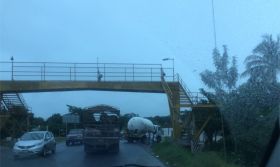
So, the problem was man-made! And could be resolved with a simple police action!! How long could it last?
When I asked this very question to several of the Mexicans around, all of them said that same thing: It will most likely last all day.
What? Demonstrators completely shut down a major thoroughfare and no one does anything about it? And furthermore, everyone takes it with good humor?
The response was simple and the same from everyone I asked: “Si.”
After taking a beat to let this sink in, I reviewed our situation:
- It was about 4 PM.
- Driving in Mexico at night in unfamiliar areas is a very bad idea.
- If we went back, it would take us about 6 hours to get to where we started, and at that point, we may or may not have a hotel room.
- Our Sprint / MovieStar phone didn’t work (but it essentially never did).
- If we didn’t get to our next destination, our whole series of reservations at hotels would be messed up.
-
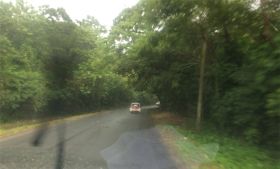 The highway was closed and very unlikely to be opened that day.
The highway was closed and very unlikely to be opened that day.
What would you do?
As I was reviewing this, Jet had a brilliant idea. I saw her approach one of the many cab drivers just standing around. From a distance, I could see (but not hear) her talking with him. Then she came over to our car. “Let’s go,” she said. “This local cabby knows the back roads and can get us on the main highway past the demonstration. All we have to do is follow him.”
Furthermore, at my suggestion (I can be less than trusting in some circumstances), the cab driver agreed not to take any money until we were safely delivered to a place on the highway that was after the closure.
.jpg)
As the rain intensified, off we went following our escort, leaving behind our new Canadian friends and somewhere more distant, the pigs we had followed for way too long. Us and a few others who evidently knew what they were doing joined the single line that had turned off onto one of the unnamed streets. Rights and lefts we made, onto streets with huge ruts, through residential, rural, and commercial areas. Bemused locals came out to watch the parade.
There were two reasons we enjoyed this second detour: 1) it was quite beautiful to see what we would have missed from the highway-- all the little homes in a pastoral setting with lush vegetation and farm animals, while accompanied by a delightful rain; and, 2) we had hope we would be back on the highway soon. And with this detour came a new, calmer way of looking at things. This out of the way, less than prosperous area was filled with nice people with every day issues much more severe than our current problem. Given the blessing of this perspective, our circumstances didn’t seem that dire after all.

After 45 minutes of this pleasant and anticipatory diversion, the ultimate object of our desire appeared in front of us: the highway. The cab driver pulled over, rolled down his window and stuck out his hand to point to the onramp. I pulled over behind him, got out of our van, ran over in the rain, thanked him, gave him the 100 pesos (about US $5) we had agreed to, thanked him again, and, as a parting gift, presented him with all we had to signify our vast appreciation and relief-- a single granola bar, which he seemed very happy to have.
We happily rolled onto the onramp and were back on our way. We wouldn’t make it to the one of a kind rustic hut in the nature preserve in Palenque that day, but we did make it to the consolation prize about two hours drive before Palenque: the Villahermosa Hampton Inn.
The rest of the day was fairly uneventful.
See links to all Mexico road trip stories below. You are currently reading the one highlighted with the yellow background.
To see hundreds of questions answered by expats already living in Mexico, click here.
To see hundreds of questions answered by expats already living in Mexico, Panama, Belize, Nicaragua and Portugal, go here and navigate to the place you're most interested in.
Sign up for the Best Places in the World to Retire newsletter. To see additional additional pictures and videos not in the stories, follow us on Facebook. To see more videos of the trip, see our YouTube channel.
Want online, interactive help finding the best place abroad for you? Try the Location Advisor.
To download free research studies conducted with over 1,000 expats currently living in Mexico, click here.
Download the free eBook of all the stories below, "Our Year on the Road & Living in Mexico-- Adventures, Challenges, Triumphs, Lessons Learned"
Links to Mexico Road Trip stories:
Editor’s note: you may freely reprint the article above, provided you put this at the beginning or end:
Content provided by Best Places in the World to Retire, which provides credible answers to questions about moving abroad, expat stories, and a location advisor to help you find the perfect place for you.
Content provided by Best Places in the World to Retire, which provides credible answers to questions about moving abroad, expat stories, and a location advisor to help you find the perfect place for you.



.png)